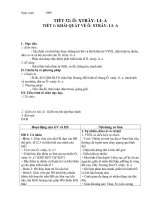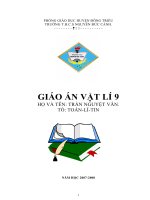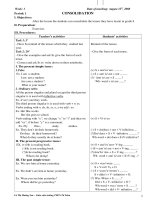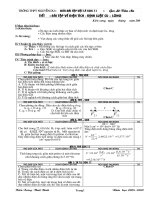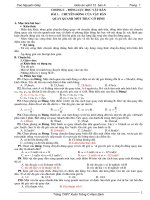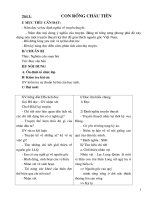GIAO AN 6-Tron bo- 2007
Bạn đang xem bản rút gọn của tài liệu. Xem và tải ngay bản đầy đủ của tài liệu tại đây (763.51 KB, 198 trang )
Trần Việt Hùng
Kế họach giảng dạy
Môn: English 6
I. Mục đích, yêu cầu
1. Nội dung
Tiếng Anh 6 là cuốn sách đầu tiên của bộ sách giảng dạy tiếng Anh 4 năm dùng
cho các trờng THCS. Nội dung sách bao gồm các chủ điểm gần gũi với cuộc sống, sát
thực với mục đích, nhu cầu và hứng thú của học sinh, gồm 16 đơn vị bài học. Mỗi đơn
vị gồm 2 đến 3 phần A, B, C tơng ứng với các chủ đề có liên quan chặt chẽ. Mỗi phần
đợc học từ 1 đến 2 bài tiết học 45 phút.
- Mở đầu là tranh ảnh hoặc các hoạt động của giáo viên
- Giới thiệu ngữ liệu mới gồm các mục nh:
Listen repeat/ Listen read nhằm giới thiệu cho các em những từ và cấu trúc mới
trong bối cảnh ngôn ngữ đợc sử dụng trong đời sống.
Các mục Ask Answer/ Practice with a partner/ Match/ True False đảm bảo cho
các em hiểu đợc các từ và cấu trúc mới và nội dung các thông tin trong bài đọc hoặc
bài đối thoại trớc khi bắt đầu thực hành.
Ngoài ra các phần Remember/ Grammar, Practice/ Glossary để củng cố thêm
sau mỗi bài học
Những đề mục trên đợc thống nhất xuyên suốt 16 đơn vị bài học với nội dung
về các lĩnh vực gần gũi với lứa tuổi học sinh tăng cờng sự giao lu văn hóa Anh
Việt.
2. Kĩ năng
Giúp học sinh rèn kĩ năng nghe, nói, đọc, viết tiếng Anh ở mức độ đơn giản
II. Đặc điểm bộ môn và học sinh
1. Thuận lợi:
- học sinh đều chăm ngoan, có ý thức học tập
- học sinh có đầy đủ sgk, vở ghi chép
- sgk đợc biên soạn một cách có hệ thống khoa học, phù hợp với trình độ của các đối
tợng
2. Khó khăn:
- đây là môn học đòi hỏi có năng khiếu cá nhân, chính vì vậy số lợng học sinh học
tốt chỉ tập trung ở một số em.
- khối lợng kiến thức còn nhiều so với khả năng tiếp thu, đặc biệt kiến thức tuy đã đ-
ợc biên soạn lại nhng còn nhiều điểm cha thực sự phù hợp.
- các em cha có sách tham khảo cũng nh sách bài tập bổ trợ để rèn luyện thêm
- là môn học cần có có sự hiểu biết tổng hợp và cần có sự sáng tạo, đòi hỏi t duy.
III. Chỉ tiêu phấn đấu
Chỉ tiêu Giỏi Khá Trung bình Yếu Kém
%
IV. Biện pháp thực hiện
1. Giáo viên
Chuẩn bị tốt bài giảng, chú trọng kiến thức trọng tâm. Có tranh ảnh trực quan và
đồ dùng dạy học
1
Trần Việt Hùng
Sử dụng các phơng pháp dạy học linh hoạt
Truyền giảng bài học đơn giản, dễ hiểu, dễ nhớ
Tổ chức một số hình thức sinh hoạt ngoài giờ giúp học sinh phát triển kĩ năng cá
nhân.
2. Học sinh
Chuẩn bị bài cũ tốt trớc khi đến lớp
Chuẩn bị bài mới, chủ động trong việc tiếp thu kiến thức
Tích cực văn dụng kiến thức đã học vào thực tế
Tham khảo các sách tham khảo, bổ trợ
V. Kế hoạch cụ thể từng bài
Bài học Nội dung kiến thức Kĩ năng Chuẩn bị
của thầy
Chuẩn bị
của trò
Unit 1
Greetings
- các cách chào hỏi, giới
thiêu tên
- hỏi và trả lời về tuổi
- đếm từ 1 - 20
- nghe, nói,
đọc, viết
- bài soạn
- tranh ảnh
- đồ dùng
dạy học(đài,
băng, bảng
phụ)
- sgk, sbt
- vở ghi
- vở bài
tập
Unit 2
At school
- giới thiệu các câu mệnh
lệnh đơn giản
- hỏi trả lời về họ tên,
địa chỉ, chỗ ở
- hỏi đáp về đồ vật và ngời
- nghe, nói,
đọc, viết
- bài soạn
- tranh ảnh
- đồ dùng
dạy học(đài,
băng, bảng
phụ)
- sgk, sbt
- vở ghi
- vở bài
tập
Unit 3
At home
- giới thiệu về mình, ngời
khác, đồ vật trong gia đình
- nói có bao nhiêu ngời
trong gia đình
- hỏi và trả lời về số lợng
- sử dụng đợc số ít/ nhiều
trong danh từ
- cách dùng của các tính
từ sở hữu
- nghe, nói,
đọc, viết
- bài soạn
- tranh ảnh
- đồ dùng
dạy học(đài,
băng, bảng
phụ)
- sgk, sbt
- vở ghi
- vở bài
tập
Unit 4
Big or
small?
- hỏi trả lời về nơi chốn
vị trí tính chất, đặc điểm
của đồ vật
- miêu tả về các sự vật, đồ
vật
- sử dụng số thứ tự
- hỏi trả lời về thời gian
và các hoạt động trong
ngày
- nghe, nói,
đọc, viết
- bài soạn
- tranh ảnh
- đồ dùng
dạy học(đài,
băng, bảng
phụ)
- sgk, sbt
- vở ghi
- vở bài
tập
Unit 5
Things I do
- nói về các hoạt động
thông thờng trong ngày
- nói tên các ngày trong
tuần, các môn học
- hỏi trả lời về môn học
gì, khi nào
- nghe, nói,
đọc, viết
- bài soạn
- tranh ảnh
- đồ dùng
dạy học(đài,
băng, bảng
phụ)
- sgk, sbt
- vở ghi
- vở bài
tập
2
Trần Việt Hùng
Unit 6
Places
- giới thiệu về bản thân
- miêu tả cảnh vật nơi
mình đang sinh sống
- hỏi và trả lời về một nơi
nào đó
- nghe, nói,
đọc, viết
- bài soạn
- tranh ảnh
- đồ dùng
dạy học(đài,
băng, bảng
phụ)
- sgk, sbt
- vở ghi
- vở bài
tập
Unit 7
Your house
- ôn lại một số phần (bài6)
- nói, hỏi trả lời về các
phơng tiện di chuyển
- nói về những việc thờng
ngày của bản thân
- nghe, nói,
đọc, viết
- bài soạn
- tranh ảnh
- đồ dùng
dạy học(đài,
băng, bảng
phụ)
- sgk, sbt
- vở ghi
- vở bài
tập
Unit 8
Out and
About
- nói, hỏi trả lời về các
hoạt động đang diễn ra ở
thời điểm hiện taị
- nói đơn giản về giao
thông đờng bộ
- nói có thể hay không thể
làm việc gì
- nói bắt buộc hay không
phải làm gì
- nghe, nói,
đọc, viết
- bài soạn
- tranh ảnh
- đồ dùng
dạy học(đài,
băng, bảng
phụ)
- sgk, sbt
- vở ghi
- vở bài
tập
Unit 9
The body
- biết tên các bộ phận của
cơ thể ngời
- miêu tả hình dáng ngời
- tên các bộ phận của đầu
và mặt
- các màu cơ bản khi miêu
tả
- nghe, nói,
đọc, viết
- bài soạn
- tranh ảnh
- đồ dùng
dạy học(đài,
băng, bảng
phụ)
- sgk, sbt
- vở ghi
- vở bài
tập
Unit 10
Staying
healthy
- nói về các cảm giác, nhu
cầu, ý muốn
- nói tên một số thức ăn,
uống thông thờng
- biết sử dụng các từ some,
any,
- nói về sở thích ăn, uống
- nghe, nói,
đọc, viết
- bài soạn
- tranh ảnh
- đồ dùng
dạy học(đài,
băng, bảng
phụ)
- sgk, sbt
- vở ghi
- vở bài
tập
Unit 11
What do
you eat?
- nắm đợc cách giao tiếp
khi mua bán
- nói về số lợng, trọng l-
ợng, giá cả
- phân biệt How much/
How many
- nói tên một số thực phẩm
- nghe, nói,
đọc, viết
- bài soạn
- tranh ảnh
- đồ dùng
dạy học(đài,
băng, bảng
phụ)
- sgk, sbt
- vở ghi
- vở bài
tập
Unit 12
Sports and
spare time
- nói tên một số môn thể
thao, giait trí
- nói, hỏi - đáp về mình/
ngời khác chơi các môn
thể thao, giải trí gì
- nắm đợc cách dùng:
How often/ once/ tiwce
- nghe, nói,
đọc, viết
- bài soạn
- tranh ảnh
- đồ dùng
dạy học(đài,
băng, bảng
phụ)
- sgk, sbt
- vở ghi
- vở bài
tập
3
Trần Việt Hùng
- nắm đợc cách dùng của
trạng từ tần xuất
- nghe hiểu các đối thoại
đơn giản nói về các hoạt
động có trạng từ tần xuất
Unit 13
Activities
and the
seasons
- nói về thời tiết các mùa
- làm gì vào từng loại thời
tiết
- nghe, nói đợc về chơi thể
thao theo mùa có sử dụng
trạng từ tần xuất
- nghe, nói,
đọc, viết
- bài soạn
- tranh ảnh
- đồ dùng
dạy học(đài,
băng, bảng
phụ)
- sgk, sbt
- vở ghi
- vở bài
tập
Unit 14
Making
plans
- nói, hỏi trả lời về kì
nghỉ
- nói về dự định kế hoạch
làm gì
- hiểu các đoạn hội thoại
về kế hoạch giả trí
- nghe, nói,
đọc, viết
- bài soạn
- tranh ảnh
- đồ dùng
dạy học(đài,
băng, bảng
phụ)
- sgk, sbt
- vở ghi
- vở bài
tập
Unit 15
Countries
- biết tên nớc và thủ đô
quen thuộc
- biết tên quốc tịch, ngôn
ngữ
- so sánh hơn của tính từ
- giới thiệu một số địa
điểm địa lí của Việt Nam
- sử dụng đợc một số từ
chỉ địa điểm địa lí
- nghe, nói,
đọc, viết
- bài soạn
- tranh ảnh
- đồ dùng
dạy học(đài,
băng, bảng
phụ)
- sgk, sbt
- vở ghi
- vở bài
tập
Unit 16
Man and the
Invironment
- sử dụng câu hỏi với How
much/ many và các tính từ
chỉ định lợng
- nói về một số hiện tợng,
động vật và tình trạng môi
trờng
- dùng: Should/ Should not
- nghe, nói,
đọc, viết
- bài soạn
- tranh ảnh
- đồ dùng
dạy học(đài,
băng, bảng
phụ)
- sgk, sbt
- vở ghi
- vở bài
tập
Teaching plan of English 6
There are 16 units in New English 6 and vocabulary, language contents are:
Unit 1: Greetings: (5 periods)
- Grammar: to be
4
TrÇn ViÖt Hïng
- Vocabulary: greetings, numbers to 20
Unit 2: At school: (6 periods)
- Grammar: imperative, the present simple tense,
possesive pronoss; indefinite articles
- Vocabulary: Shool and class vocab Locations
Unit 3: At home: (6 periods)
- Grammar: The present simple tense; to be; possesive
pronouns; personal pronounds;
How many ... ? there is/ are ...
- Vocabulary: Objects in the house/ school. family
relationships, occupations, numbers to 100; question - words
Unit 4: Big or samll:(6 periods)
- Grammar: Adjectives, possesive' "S'"; to have, time
- Vocabulary: places; adjectives; ordinal numbers to 10
habitual activities
Unit 5: Things I do: (7 lessons)
- Grammar: The present simple tense; prepostition at; adv of time
- Vocabulary: Adjectives; adverbs of time; question words; classes
Unit 6: Places (6 lessons)
- Grammar: Prepositions of position; question words where, which; what
- Vocabulary: Location, surroundings; adj, prepositions
Unit 7: Your house (6 lessons)
- Grammar: Indenifite articles a / an; adverbial phrases
- Vocabulary: Places and playouts; adj; transportations.
Unit 8: Out and about (7 lessons)
- Grammar: Present progressive tense, can, can't; must/ mustn't
- Vocabulary: Habitual actions; means of transportation road signs.
Unit 9: The body (5 lessons)
- Grammar: The present simple tense; adjectives;
- Vocabulary: Parts of the body; adj, colors.
Period 1
Introducing the way of leaning E.6
NS: 03/9/07
ND: 07/9/07
I. Objectives: By the end of the lesson sts will be able to get aquainted with the kinds
of English lessons; understand and use classroom English, body gestures.
II. Language content: The content of the book.
5
TrÇn ViÖt Hïng
III. Method: Questionaire, explaination, introduction.
Iv.Teaching aids: The book, teaching plan.
v. Procedure.
A- Four typical kinds of learning
- Grammar & Vocabulary lessons - Reading lessons
- Listening lessons - Writing lessons
1 - Stages and steps in a grammar and vocabulary lesson.
a - Presentation stage: Sts learn vocab → check vocab → learn moded
sentences → concept check.
b - Practice stage: Sts use new target to practice speaking.
c - Production stage: Sts produce what they've learnt using new target iterms by
speaking, rewriting ...
2 - Stages and steps in a skill lesson ...
a - Pre - stage: Sts learn vocah → check vocab → sts brainstorm st they will
learn.
b - While - stage: Sts do the main task of a skill lesson.
c - Post - stage: Sts further practice in doing the task of the lesson or produce
what they've learnt.
B - Classroom English and body gestures - Listen, please.
- Listen and repeat, please.
- Again, please
- Do you know it in English ? What's it in English, Vietnamese) ?
- Have you finished ? (Yes, not yet)
- Work in pair / group
- Change (the role), please.
- Match, please.
- I ask, you answer.
- Go to the board, please.
- Take turn, in turn, please.
- Where's stress ?
- My voice is up or down ?
C. The way writing an English lesson in sts' notebooks
6
Trần Việt Hùng
- Date ......./........./ (ngày tháng năm)
- Unit (tên bài học)
- Period:............. (tên tiết học: Mục A/B/ C; phần 1/2/3 ...)
For grammar & vocab lessons: sts write in their notebooks 3 main parts:
1 - Vocabulary
2 - Model sentences
3 - Practice / further practice.
For skill lessons: Sts write in their notebooks 3 main parts
1 - Pre - spe listening / reading / writing
2 - While - listening / reading / writing
3 - Post -listening / reading / writing
D. Introducing new English 6
New English 6 divides into 16 units. In 16 these units, there are difference
topics, tasks, grammar; language focus, language review. In every single unit there are
parts which sts have to do. Listen and repeat, practice / practice with a group / practice
with a partner / write in your exercise book.
E.The rules for sts in class
- Sts must listen to the teacher carefully and follow all her requests.
- Sts use short answers only to answer teacher's checking questions.
- Sts have to both listen to the teacher / answer the questions and write new
words in their notebooks in presenting vocab. steps.
* Homework: Prepare the necessary books and notebooks .
Prepare for the next: Unit I- A1 4.
unit 1: greetings NS: 07/ 9/ 07
Period 2: A - Hello - A1 4 (P10 - 11) ND: 11/ 9/ 07
I. Objectives: By the end of the lesson sts will be able to introduce oneself & count
from 1 to 10
II. Language contents: - Grammar: to be (present simple tense)
- Greeting vocabulary
III. Work arrangements: - T - W.C, pairwork, groupwork
7
TrÇn ViÖt Hïng
IV. Materials: Word cues; New English 6.
V. Procedure
1. Warm up :
- Greetings: in Vietnamese or English.
2. Presentation:
a. Pre - teach vocab (1):
- hi / hello (visual P.10): Chµo (gÆp mÆt)
- name (example): tªn
* Checking vocab: Rub out and remember
* Pre - teach vocab (2): (visual)
1 - oh = 0 4 - three = 3
2 - one = 1 5 - four = 4
3 - two = 2 6 - five = 5
- checking vocab: Slap the board
b. Presentation dialogue: (dialogue build)
T - sets the scene & elicits ... Nam
* Model sentences:
a - Lan: Hi, I'm Lan b - Ba: Hello, my name's Ba
Nga: Hi, I'm Nga Lan: Hello, My name's Nam
* Concept check: - Meaning:
- Use: Greet people, identify oneself
- Form: Hi, I'm + tªn
: Hello, my mame's + tªn
(Note: I am = I'm; My name is = My name's)
• Intonation: MS
3. Practice.
Practice 1: Sts listen and repeat A
3
p11 then practice A
4
p11
- Ss listen and repeat again.
- Ss introduce themselves: Chain reaction.
- eg. Hi.
Hello.
8
TrÇn ViÖt Hïng
My name is Nga.
I am Nga.
Practice 2 Dictation. T - reach: one, three, five ... Sts write 1,3,5 ...
* Word cue drill (5')
Example exchange: S
1
- Hai Duong, please Hai Duong - 032
S
2
- 032 Ha noi - 04
4. Further practice
*Guessing game
Example exchange: S
1
- oh three
S
2
- Yes (No)
5. Home work.
- Make 2 dialogues following the model sentences
- Learn vocab in the context
- Do exercises 1 + 2 (work book) P.4
unit 1: greetings NS: 08/ 9/ 07
Period3: A - Hello - A5 → 8 (P12 - 13) ND: 12/ 9/ 07
I. Objectives: By the end of the lesson sts will be able to greet each other, count
from 6 to 10 and ask how people are.
II. Language contents: - Grammar: to be (present simple tense)
- Greeting vocabulary
III. Work arrangements: - T - W.C, pairwork, groupwork
IV. Materials: New English 6
V. Procedure
1. Warm up.
* Jumbled words.
9
TrÇn ViÖt Hïng
- ifev --> five
- wot --> two
- rhtee --> three
- noe --> one
- eanm --> name
- rouy --> your
2. Presentation
a. Pre - teach vocab.
checking vocab: what & where
- fine (a) (explanation): khoÎ
- Thanks: thank you (situation): c¶m ¬n
- Miss + tªn (exp) c« (cha cã chång)
- Mr + tªn (exp) «ng, ngµi
- six = 6
- seven = 7
- eight = 8
- nine = 9
- ten = 10
* checking vocab: what & where
b. Presentation dialogue: (Rub out remember dialogue)
T. sets the scense and elicits
* Model sentences: Ba Mary
Ba: Hi, Lan.
Lan: Hello, Ba.
Ba: How are you ?
Mary: I’m fine , thank you. And you?
Ba: Fine, thanks.
+ Concept check: - Meaning
- Use: Greeting and asking how people are.
- Form:
How are you ?
( I’m) Fine, thanks/ thank you.
10
6
7
8
10
9
TrÇn ViÖt Hïng
Intonation: Ms
3. Practice
Sts practice A6: Ss work in pairs to make similar dialogues between: Miss Hoa and
Mr Hung; Nam and Nga.
eg. S1: - Hello, Miss Hoa.
S2: - Hi, Mr Hung.
S1: - How are you?
S2: - I’m fine, thanhs. And you?
S1: - Fine, thanks.
* then write A7 p.13 Key: The missing words:
Lan; are you; fine; thanks.
* Practice 2: Dictation:
T - tells: Sts listen and write down these phone numbers:
855469/ 857763 / 890517 / 845273 / 850858
* Jumbed words (poster 2)
- wot → two = 2 etrhe → three = 3 eno → one = 1
- ho → oh = 0 thgie → eight = 4 neves → seven = 7
4. Production.
* Chain reaction: Ss work in pairs to make the same dialogues.
- Call on some pairs to act out.
- Correction.
5. Homework:
1 - Make 2 dialogues following the M-S
2 - Do E3 + 4 P5 (workbook)
3 - Learn by heart the vocab.
11
TrÇn ViÖt Hïng
unit 1: greetings NS: 10/9/2007
Lesson 4: B - Good morning B1 - 6 (P14 16) – ND:14/9/2007
I. Objectives: By the end of the lesson sts will be able to greet each other, using
"were" & count brom 10 to 15
II. Language contents: - Grammar: to be (present simple tense)
- Vocabulary: you and me
III. Materials: New English 6; picture cues
IV. Work arrangements: T - WC, pairwork; groupwork
V. Procedure
1. Warm up: Slap the board
Ss play in two groups to slap on the word they hear.
one
2. Presentation 1: B1 - 2 - 3 P16
* Pre - teach vocab/ checking vocab: Slap the board
12
TrÇn ViÖt Hïng
- good morning (exp) xin chµo (buæi s¸ng)
- good afternoon (exp) xin chµo (buæi chiÒu)
- good evening (exp) xin chµo (buæi tèi)
- good bye (mine) t¹m biÖt
- children (visual P15) trÎ em, trÎ con, c¸c em
- we ( translation) chóng t«i, chóng ta
- eleven = 11 thirteen = 13 fifteen = 15
- twelve = 12 fourteen = 14
* Presentation dialogue B3 P15
3. Practice
Practice 1: Picture drill. Example: S
1
: Good morning
S
2
: Good morning
- Sts listen and repeat B3
- Roleplay: Ss work in pairs to practice the dialogue between Miss Hoa and her
Ss; Mom and Lan.
- Call on some pairs to act out.
- Written exercise: B4 - P16: Let Ss do in their notebooks, then ask a S to give
his/ her answer.
* Key answer:
Lan: Good afternoon, Nga.
Nga: Good afternoon, Lan.
Lan: How are you?
Nga: I am fine, thanks. And you?
Lan: Fine, thanks.
Nga: Goodbye.
Lan: Bye.
* Practice 2: Piture drill: Example exchange: S
1
: five and eight
S
2
: thirteen
13
5 + 8
3 + 7
4 + 11
9 + 6
TrÇn ViÖt Hïng
4. Further parctice: Bingo
- Ss write numbers 0 → 15 in their books. Ss choose 5 their numbers.
T - reads 5 her numbers. Ss check and put (v) on words they've choosen
5. Homework
- Read B1 - 4
- Do B1 - 3 P6 - 7 (workbook)
- Prepare for the next: C1- 4
unit 1: greetings NS: 15/9/2007
Lesson5 : c- how old are you? c1, 2,4 (P17 - 19) ND: 18/9/2007
I. Objectives: After the lesson sts will be able to count from 16 to 20 and ask for and
answer about age.
II. Language contents: - Grammar: to be (present simple tense)
- Vocabulary: cardinal numbers
III. Materials: New English 6; cassette; teaching plan
IV. Work arrangements: T - WC, pairwork; groupwork; individual.
V. Procedure
1. Warm up: Jumbled words * Ss write
- eevtwl - twelve
- tefeifn - fifteen
- treetihn - thirteen
- eefturo - fourteen
2. Presentation:
a. Pre - teach vocab (visual)
- sixteen = 16 nineteen = 19
14
TrÇn ViÖt Hïng
- seventeen = 17 twenty = 20
- eighteen = 18
- old --> translation
- How old --> situation Miss Hoa
* Checking vocab: Slap the board
b. Presentation dialogue (Dialogue build)
+ Model sentences: Mrs Hoa: How ↑ old are you ↓ ? Lan
Lan: I'm eleven. ↓
+ Con cept check: - Meaning
- Use: Talking about age
- Form: How old are you ?
I'm + number of age
(Note: How old are you ? ≠ How are you ?)
- Intonation: M.S
3. Practice :
1.Slap the board.
- Ss have 2 groups of 5: Listen and slap on the numbers read by the teacher.
- Praise the winner.
2.Picture drill
Example exchange S
1
: How old are you ?
S
2:
I'm twelve
12 20 18 11 19 13 15 17 16 14
4. Production:
* Complete the dialogue
S1- Good morning. My ................ is Nga.
S2- Good morning. I ............... Lan. ................. are you?
S1- I ............... fine, thanks. ................ you?
S2- ..............., thanks. I’m 11. How ............ are you?
S1- I’m 11, too.
5. Homework
- Learn by heart the new vocabulary.
- Do C1 + 2 (workbook).
- Prepare for the next: C3,5,6
15
TrÇn ViÖt Hïng
unit 1: greetings NS: 16/9/2007
Lesson 6 : C - How old are you ? C 3,5,6 (P19) ND: 19/9/2007
I. Objectives: By the end of the lesson sts will be able to count from 1 → 20 fluently
and give the telephone numbers and how to introduce a person.
II. Language contents: - Grammar: to be (present simple tense)
- Greeting vocabulary
III. Materials: New English 6
IV. Work arrangements: T - WC, pairwork; groupwork; individual.
V. Procedure
1. Warm up
* Pelmanism
one two three four five ten eleven twelve twenty
1 2 3 4 5 10 11 12 20
2. Presentation
16
TrÇn ViÖt Hïng
a. Vocabulary
- this (dem.) --> example
b. Model sentence
This is Phong.
This is Miss Lien.
3. Practice
a. Listen and practice the dialogues(p. 18)
- Let Ss listen to the dialogues and repeat them.
- Ask Ss to practice the dialogues in groups of 3.
- T goes round to correct mistakes, then ask some pairs to act out before clas
b - Jumble words (poster)
tgieh = eight = 8 treniteh = thirteen = 13 lewter = twelve = 12
neelve = eleven = 11 ytwnet = twenty = 20 otrenouf = fourteen = 14
eevsn = seven = 7 ientenen = nineteen = 19 owt = two = 2
net = ten = 10 ixs = six = 6 oufr = four = 4
c - Dictation and picture cue drill
048561201 0918863450
0912081417 071946821
033276402 060783415
4. Production:
* Survey
- Sswork in groups of 4 or 5 to ask about the age, then
report before class
eg. Lan is 12, Hong is .............
* Make the same dialogues like the given ones.
- Ss work in groups of 3
eg. S1- Hello, Nam. This is Mai.
S2- Hi, Mai. How old are you?
S3- I’m eleven.
5. Homework:
- Review the whole unit
- Do the rest of C in the workbook
- Prepare for the next: Unit 2 –A 1,2,3,4
17
Name age
1.Lan
2.Hong
3.Nam
4.Nhung
12
TrÇn ViÖt Hïng
unit 2: at school NS: 18/9/2007
Period 7 : A - Come in A1 - 4 (p.20 - 22) ND: 21/9/2007
I. Objectives: By the end of the lesson sts will be able to understand and give some
imperatives in class.
II. Language contents: - Grammar: Imparatives.
- School and classroom vocabulary
III. Materials: New English 6, posters
IV. Work arrangements: T - WC, pairwork; individual.
V. Procedure
1. Revision: (Noughts & crosses)
10 : 2 = 4 + 16 = 20 - 5 =
3 - 3 = 16 + 4 = 6 x 3 =
9 - 5 = 20 - 7 = 10 + 4 =
Note: Ss give the answer only
2. Presentation
18
Trần Việt Hùng
* Pre - teach vocabulary
1 - (to) come in (mime): đi vào
2 - (to) sit down (mime): ngồi xuống
3 - (to) stand up (antonym): đứng lên
4 - (to) close your book (mime): gập sách lại
5 - (to) open your book (mime): mở sách ra
* Checking vocab: Slap the board
* Presentation text: A1 P21 (T - reads. Ss listen and repeat)
3. Practice
Matching: A2 P21 (Ss match pictures with the suitable command)
- Mime drill (T - mimes / Ss look and say)
Example exchange: T: (Open your books)
S: Open your books.
- GameSimon say: A3 P22 (Ss play the game)
- Ss listen / repeat A1 P.20 then practice with a partner
4. Further practice: (T - W. C; half - half; open - pair; closed - pair
Example exchanges:
S
1
: Good morning.
S
2
: Good morning, Miss Hoa.
S
1
: How are you ?
S
2
: We're fine. How ... ?
S
1
: Fine, thanks. Sit down.
5. Homework
- Read and translate A1 into Vietnamese
- Do A1 - 2 (p.11) - workbook
19
Miss Hoa Children
... morning
How ... ?
Fine ... Sit...
And open.....
morning, Miss Hoa ...
We're ... How ...
Yes, Miss.
Yes, Miss.
TrÇn ViÖt Hïng
unit 2: at school NS: 22/9/2007
TiÕt 8: Where do you live ? B1-2 (P23 - 24) ND: 25/9/2009
I. Objectives: By the end of the lesson sts will be able to talk about the places.
II. Language contents: - Grammar: Present simple tense, Possesive pronouns
indifinite articles: a / an
- School / classroom and locative vocabulary
III. Materials: New English 6; cues, a poster
IV. Work arrangements: T - WC, pairwork; groupwork; individual.
V. Procedure
1. Warm up
* “Simon say” game
2. Presentation
a. Pre - teach vocab. *Checking vocab.: Matching (poster 1
live (v) --> translation
a house (n) --> drawing
a street (n) --> example
a city (n) --> example
b. Presentation dialogue: (dialogue build)
* Model sentences:
Nam: Where do you live ?
Lan: I live on Tran Phu street
20
TrÇn ViÖt Hïng
in a house.
in a city.
in Hai Duong.
in Viet Nam.
* Concept check: - Meaning: ..... / Intonation: MS
- Use talking about the place you live.
- Form: (Subtitution)
3. Practice: Word cue drill. Then ss listen & repeat B1, p23
Example exchanges:
S
1
: - Where do you live ?
S
2
: - On Le Loi street.
* Noughts & erosses
4. Production
Survey: T - divides ss into groups of 4 or 5; T - gives instruction & models
Each st asks and fills in information about the others. T - finds out the winner.
Example exchange: S
1
: What's your name ? S
1
: Where do you live ?
S
2
: My name's Hoa S
2
: TranPhu street in HD city.
5. Homework:
- Make 2 dialogues following the MS.
- Do B3 - 6 p12 - 13 (work book)
21
Le Loi street a house HCM city
a house Nguyen Trai HCM city
a street Da Nang a city
Dong Hoi Hang Bong st Long Xuyen
TrÇn ViÖt Hïng
unit 2: at school NS: 22/9/2007
Period 9: B Where do you live ? B3- 4- 5- 6 (p.24 - 25) ND: 26/9/2007
I. Objectives: By the end of the lesson sts will be able to:
- Pronounce the alphabet.
- Greet and spell their names.
II. Language contents:
- Grammar: Present simple tense; Possesive pronouns
- The alphabet
III. Materials: New English 6; cues, a poster
IV. Work arrangements: T - WC, pairwork; groupwork; individual.
V. Procedure
1. Revision: * Write it up
T - checks ss' doing homework and gives instruction of writing survey from
(unit 2) lesson 2
Eg: Hoa lives on Pham Ngu Lao street, in Hai Duong city.
2. Presentation
* Presentation B3 P.24
* Pre - teach vocab. The alphabet B3 p.24
* Practice B3 P.24
* Shark attack
Eg: .......... (house)
22
TrÇn ViÖt Hïng
* Bingo (using the letters in the alphabet)
* Presentation B4 P.25
Presentation dialogue (Rub out and remember dialogue)
• Model sentences:
Miss Van: What is your name?
Lan: My name is Lan.
Miss Van: How do you spell your name (it) ?
Lan: : L - A – N, Lan.
* Concept check: - Meaning ...
- Use: talking and spelling the names
- Form: How do you spell it (your name) ?
(give real spelling)
- Intonation: MS
3. Practice B 4 P25
Word cue drill
Example exchange:
S
1
: What's your name ?
S
2
: My name's Lam
S
1
: How do you spell it ?
S
2
: L - A - M; Lam
Sts listen and repeat B4. P25
4. Production
* Matching
A B
1. Good morning.
2. How are you?
3. How old are you?
4. What’s your name?
5. Good bye.
6. Where do you live?
7. How do you spell your
name?
a. Good bye.
b. Good morning.
c. I live in Hanoi.
d. I’m fine, thanks. And
you?
e. I’m eleven.
f. My name’s Lan.
g. L- A- N, Lan.
5. Homework
- Learn by heart the alphabet and the new vocab.
- Do the ex. of B in the w.b
23
Lam Viet Anh
Minh Xuan Mai
Hai Cuong
TrÇn ViÖt Hïng
- Prepare for the next: C1.
TiÕt 10 unit 2: at school NS: 21/9/2006
Lesson 4: B Where do you live ? B5+6 (P25) ND: 28/9/2006
I. Objectives: By the end of the lesson sts will be able to ask for and give personal
information, Indentify oneself, others and the places.
II. Language contents:
- Grammar: Present simple tense. Possesivepro
- School / classroom & locative vocabulary
III. Materials: New English 6; cues, cards; posters.
IV. Work arrangements: T - WC, pairwork; groupwork; individual.
V. Procedure
Further practice:
1.Slap the board: (5')
* Dictation list: T - reads the letters in the alphabet
Sts write in colunms follwing the pronunciation
Eg: Exchange: a - h - j - k
* Shark attack or hangman: (5')
Eg: Exchange ........ (morning) ........ (eight)
2. Written exercise B5 - P25: (5')
T - give instruction. Sts write the answers in their notebooks.
3. Lucky numbers: (Poster) (10')
1 - How old are you ?
2 - Lucky number
3 - Where do you live ?
4 - What's your name ?
5 - Lucky number 8 - Lucky number
24
a
b
c
f
g
w
1 2 3 4 5
6 7 8 9 10
TrÇn ViÖt Hïng
6 - How do you spell your name ? 9 - What's your street's name ?
7 - What's the name of your city ? 10 - How are you ?
4. Nought and crosses (10')
- T - divides sts into 2 groups
- Sts play the game
- T - finds out the winner
5. Homework (3')
- Review all grammar notes in B6 "Remember" and make dialogues with them.
unit 2: at school NS: /10/2006
Period10: C-My school - C1 (P26 + 27) ND: /10/2006
I. Objectives: By the end of the lesson sts will be able to talk about people and things
at school.
II. Language contents:
*Grammar:- Present simple tense of to be, Possesive pronouns
- Indifinite articles: a / an, demonstratives this / that ...
* Vocabulary: School / classroom and locative vocabulary
III. Materials: New English 6; cues, cards; posters.
IV. Work arrangements: T - WC, pairwork; individual.
V. Procedure
1. Revision: T - checks sts' vocab (writing game)
2. Presentation:
* Pre - teach vocab: (7')
1. a teacher (example): c« (thÇy) gi¸o
2. a student (example): häc sinh
3. a school (explanation): trêng häc
4. a class (explanation): líp häc
5. a desk (realia): bµn häc sinh
6. a classroom (realia): phßng häc
* Checking vocab: Matching (porter) (2')
3. Presentation dialogue: (Rub out and remember dialogue) 10'
25
Lan 12 Le Loi street
Thanh fine, thanks 13
Hue a house Viet nam
